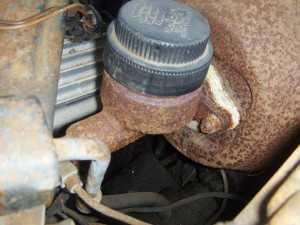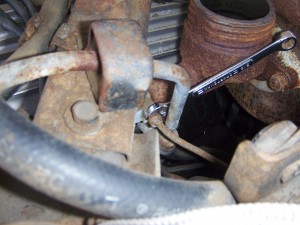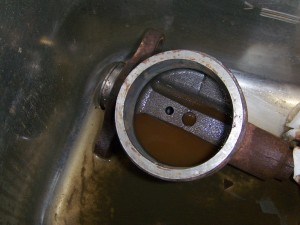Without knowing the exact source of a brake leak, the master cylinder is a good place to start work on an older car.

I had to use an oil filter wrench to get the cap off the rusty master, and when I did, I found that the reservoir was empty.
The first step is removing the master from the car, usually just a matter of two bolt at the firewall or brake booster and disconnecting the brake lines themselves. The ’64 Thunderbird has a single circuit for front and rear brakes (not as safe as modern cars, which put front and rear on separate circuits so one failure won’t mean a total loss of stopping power). There are three brake line connections, two for the front, one for the rear.
I removed the bolts and loosened the rear brake line, but the two front lines were frozen–and stripped.

With the master cylinder free, I unscrewed it from the brass distributor and got it to the workbench.
A snap ring holds the entire piston assembly together. Once out, the unit comes apart pretty easily. Some brake cleaning fluid and elbow grease are all that’s necessary to clean out the reservoir and cylinder.
I purchased a rebuild kit from a local auto parts store. As it turned out, some of the parts did not fit well, but I was able to replace the spring and all of the seals. I reused the old piston, which did not appear to be original, but was still in good condition. At least it fit–the replacement was too large to move smoothly in the bore.
Once together and back in the car, I had brakes again–briefly. I had stopping power long enough to move the car from the street to the driveway. Fluid

was leaking out of the brake system fast enough to pool on the ground, and burn copiously on the exhaust manifold, but it wasn’t coming from the master cylinder after all–the source was actually a crack in the brass distributor.
No fix for that but a new part, which was finally delivered today. With luck, the T-Bird should be on the road tomorrow.
